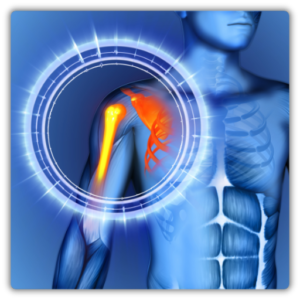What is Thoracic Outlet Syndrome and How Does it Affect Shoulder Pain?
 Thoracic Outlet Syndrome (TOS) is a condition caused by the compression of nerves and blood vessels between the collar bone and the first rib. Symptoms may include neck pain, shoulder pain, rib pain, and chest pain, often radiating along the shoulder girdle and upper back.
Thoracic Outlet Syndrome (TOS) is a condition caused by the compression of nerves and blood vessels between the collar bone and the first rib. Symptoms may include neck pain, shoulder pain, rib pain, and chest pain, often radiating along the shoulder girdle and upper back.
This compression can lead to muscle spasms and myofascial pain, with sharp pain affecting the scapula and shoulder joint. The costovertebral joint and vertebra may also contribute to the pain, causing discomfort that is made worse with certain movements.
Rehabilitation is essential for managing TOS, focusing on relieving rib articulating tension and improving spinal alignment. Treatment of rib dysfunction and addressing any extra rib presence can provide effective pain relief and restore function to the affected area.
KEY POINTS
Thoracic Outlet Syndrome (TOS) occurs when nerves and blood vessels are compressed between the collarbone and first rib, causing pain in the neck, shoulders, ribs, and upper back.
Poor posture, joint dysfunction, and muscle strain can contribute to rib and shoulder pain, often requiring physical therapy or chiropractic care for relief.
Non-invasive treatments, such as stretching, postural training, and myofascial release, can help manage pain, while severe cases may require medical intervention.
Seeking professional help is crucial if pain persists, worsens, or is accompanied by symptoms like numbness, tingling, or difficulty breathing.

Pop in your email below, and we’ll zip it straight to your inbox so you never lose it!
What are the Common Causes of Rib and Shoulder Pain?
Common causes of rib and shoulder pain often involve issues related to the shoulder blade, rib cage, and surrounding muscles. One prevalent cause of shoulder pain is a sprain of the shoulder muscle or joint dysfunction, which can lead to back pain and radiating pain along the neck and shoulder. Additionally, trigger points in the upper ribs or thoracic vertebrae may create a tingle sensation as they affect nearby nerves or blood vessels.
Conditions like neurogenic tos and compression of the brachial plexus can also be sources of pain, particularly in the mid back. The cause of thoracic pain may stem from postural issues or injuries that result in strained intercostal muscles. In some cases, fractures can result, making a comprehensive treatment plan essential. Seeking help from a physiotherapist could be vital to relieve symptoms and restore range of motion.
Looking to take control of your weight & nutrition?

How Can Poor Posture Contribute to Shoulder Pain?
Poor posture, such as slumping while sitting or standing, can lead to shoulder pain by affecting the spine’s alignment. When the clavicle is improperly positioned, it can compress nerves and disrupt blood vessels or nerves, causing pain that is commonly felt in the arm and hand.
This misalignment may also contribute to rotator cuff dysfunction, where muscles and ligaments surrounding the joint become strained. Manual therapy may be necessary to relax the muscles and restore strength and stability, particularly if scoliosis or whiplash is involved.
If the costotransverse and costovertebral joints are affected, facet joint dysfunction can occur, leading to further complications. In severe cases, surgical treatment may be required to alleviate symptoms associated with impingement or when a vessel is compressed. Appropriate treatment is essential for managing these issues effectively.
What are the Treatment Options for Rib and Shoulder Pain?
How Can Chiropractic Care Help with Shoulder Pain?

Chiropractic care can effectively address shoulder pain that may be due to issues like a cervical rib. This condition can lead to symptoms of thoracic outlet syndrome, where pain occurs along the rib and affects the anterior shoulder region.
By focusing on the cervical spine and surrounding structures, chiropractors can alleviate ligamentous tension and improve current health. Additionally, treatment may help identify the underlying cause thoracic issues, ultimately reducing the occurrence of the syndrome occurs in patients.
What Role Does Physical Therapy Play in Treating Thoracic Outlet Syndrome?
Physical therapy plays a crucial role in treating Thoracic Outlet Syndrome by enhancing mobility and reducing pain. Therapeutic exercises strengthen the surrounding muscles, improving posture and alleviating pressure on the nerves and blood vessels.
Additionally, manual techniques and stretching can help restore normal function and range of motion, contributing to long-term recovery.
Are There Non-Invasive Treatments for Rib Dysfunction?
Non-invasive treatments for rib dysfunction include a variety of approaches aimed at relieving pain and restoring mobility. Techniques such as physical therapy, chiropractic adjustments, and myofascial release can effectively address underlying issues without surgery. Additionally, breathing exercises and postural training may aid in reducing discomfort and improving rib function.
What Can You Do at Home to Alleviate Rib and Shoulder Pain?
To alleviate rib and shoulder pain at home, consider incorporating gentle stretching exercises into your routine. Focus on stretches that target the upper back and shoulders to improve flexibility and reduce tension. Additionally, applying a warm compress can help relax tight muscles and ease discomfort. Maintaining good posture while sitting and standing is crucial; use ergonomic furniture if possible. Finally, ensure you are getting enough rest and consider over-the-counter pain relief if necessary, following your doctor’s advice.
When Should You Seek Professional Help for Rib and Shoulder Pain?
When experiencing persistent rib and shoulder pain, it’s crucial to seek professional help, especially if the discomfort radiates from the thoracic spine. If pain is accompanied by symptoms like shortness of breath or numbness, immediate medical attention is necessary to rule out serious conditions.
Additionally, if the pain interferes with daily activities or worsens over time, consulting a healthcare provider can provide insights into underlying issues and appropriate treatments.











